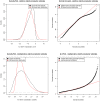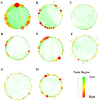Layered signaling regulatory networks analysis of gene expression involved in malignant tumorigenesis of non-resolving ulcerative colitis via integration of cross-study microarray profiles
- PMID: 23825635
- PMCID: PMC3692446
- DOI: 10.1371/journal.pone.0067142
Layered signaling regulatory networks analysis of gene expression involved in malignant tumorigenesis of non-resolving ulcerative colitis via integration of cross-study microarray profiles
Abstract
Background: Ulcerative colitis (UC) was the most frequently diagnosed inflammatory bowel disease (IBD) and closely linked to colorectal carcinogenesis. By far, the underlying mechanisms associated with the disease are still unclear. With the increasing accumulation of microarray gene expression profiles, it is profitable to gain a systematic perspective based on gene regulatory networks to better elucidate the roles of genes associated with disorders. However, a major challenge for microarray data analysis is the integration of multiple-studies generated by different groups.
Methodology/principal findings: In this study, firstly, we modeled a signaling regulatory network associated with colorectal cancer (CRC) initiation via integration of cross-study microarray expression data sets using Empirical Bayes (EB) algorithm. Secondly, a manually curated human cancer signaling map was established via comprehensive retrieval of the publicly available repositories. Finally, the co-differently-expressed genes were manually curated to portray the layered signaling regulatory networks.
Results: Overall, the remodeled signaling regulatory networks were separated into four major layers including extracellular, membrane, cytoplasm and nucleus, which led to the identification of five core biological processes and four signaling pathways associated with colorectal carcinogenesis. As a result, our biological interpretation highlighted the importance of EGF/EGFR signaling pathway, EPO signaling pathway, T cell signal transduction and members of the BCR signaling pathway, which were responsible for the malignant transition of CRC from the benign UC to the aggressive one.
Conclusions: The present study illustrated a standardized normalization approach for cross-study microarray expression data sets. Our model for signaling networks construction was based on the experimentally-supported interaction and microarray co-expression modeling. Pathway-based signaling regulatory networks analysis sketched a directive insight into colorectal carcinogenesis, which was of significant importance to monitor disease progression and improve therapeutic interventions.
Conflict of interest statement
Figures





Similar articles
-
Identification of disrupted pathways in ulcerative colitis-related colorectal carcinoma by systematic tracking the dysregulated modules.J BUON. 2016 Mar-Apr;21(2):366-74. J BUON. 2016. PMID: 27273946
-
Screening of the shared pathogenic genes of ulcerative colitis and colorectal cancer by integrated bioinformatics analysis.J Cell Mol Med. 2024 Mar;28(5):e17878. doi: 10.1111/jcmm.17878. Epub 2023 Jul 26. J Cell Mol Med. 2024. PMID: 37494129 Free PMC article.
-
Functional and protein‑protein interaction network analysis of colorectal cancer induced by ulcerative colitis.Mol Med Rep. 2015 Oct;12(4):4947-58. doi: 10.3892/mmr.2015.4102. Epub 2015 Jul 20. Mol Med Rep. 2015. PMID: 26239378 Free PMC article.
-
An Overview of Molecular Profiles in Ulcerative Colitis-Related Cancer.Inflamm Bowel Dis. 2018 Aug 16;24(9):1883-1894. doi: 10.1093/ibd/izy221. Inflamm Bowel Dis. 2018. PMID: 29945208 Review.
-
Cancer systems biology: exploring cancer-associated genes on cellular networks.Cell Mol Life Sci. 2007 Jul;64(14):1752-62. doi: 10.1007/s00018-007-7054-6. Cell Mol Life Sci. 2007. PMID: 17415519 Free PMC article. Review.
Cited by
-
KIAA0101 is associated with human renal cell carcinoma proliferation and migration induced by erythropoietin.Oncotarget. 2016 Mar 22;7(12):13520-37. doi: 10.18632/oncotarget.5876. Oncotarget. 2016. PMID: 26575329 Free PMC article.
-
Molecular pathogenesis involved in human idiopathic pulmonary fibrosis based on an integrated microRNA‑mRNA interaction network.Mol Med Rep. 2018 Nov;18(5):4365-4373. doi: 10.3892/mmr.2018.9456. Epub 2018 Sep 5. Mol Med Rep. 2018. PMID: 30221703 Free PMC article.
-
Microarray analysis points to LMNB1 and JUN as potential target genes for predicting metastasis promotion by etoposide in colorectal cancer.Sci Rep. 2024 Oct 10;14(1):23661. doi: 10.1038/s41598-024-72674-8. Sci Rep. 2024. PMID: 39390002 Free PMC article.
-
Clarifying the molecular mechanism associated with carfilzomib resistance in human multiple myeloma using microarray gene expression profile and genetic interaction network.Onco Targets Ther. 2017 Mar 1;10:1327-1334. doi: 10.2147/OTT.S130742. eCollection 2017. Onco Targets Ther. 2017. PMID: 28280367 Free PMC article.
-
Proteomics and bioinformatics analysis of mouse hypothalamic neurogenesis with or without EPHX2 gene deletion.Int J Clin Exp Pathol. 2015 Oct 1;8(10):12634-45. eCollection 2015. Int J Clin Exp Pathol. 2015. PMID: 26722453 Free PMC article.
References
-
- Hendon SE, DiPalma JA (2005) U.S. practices for colon cancer screening. Keio J Med 54: 179–183. - PubMed
-
- Devroede GJ, Taylor WF, Sauer WG, Jackman RJ, Stickler GB (1971) Cancer risk and life expectancy of children with ulcerative colitis. N Engl J Med 285: 17–21. - PubMed
-
- Yancik R (2005) Population aging and cancer: a cross-national concern. Cancer J 11: 437–441. - PubMed
Publication types
MeSH terms
LinkOut - more resources
Full Text Sources
Other Literature Sources
Medical
Research Materials
Miscellaneous

